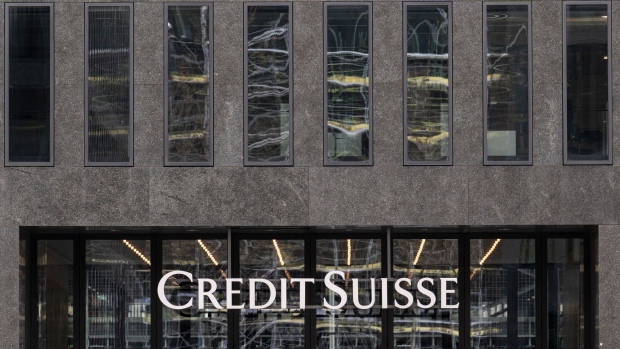Mar 23, 2023
EU Regulators to Rethink Liquidity After Credit Suisse Unravels
, Bloomberg News

(Bloomberg) -- The rapidly unfolding crises of confidence at Credit Suisse Group AG and Silicon Valley Bank are prompting some regulators gathered at the European Central Bank to rethink their treatment of liquidity risk.
The watchdogs are in the early stages of considering how to improve banks’ liquidity management, according to people familiar with the matter. While no formal discussions are underway, individual regulators sitting on the ECB’s Supervisory Board say they want a better picture of the share of deposits that lenders can expect to retain during a crisis, the people said, asking not to be identified discussing private conversations.
Even small changes to the approach to liquidity could have profound effects on how banks steer their businesses. Global regulators tightened liquidity standards after the 2008 financial crisis, yet the rise of digital banking since then has allowed depositors to move funds with a few clicks. Social media, meanwhile, also amplifies the risk of bank runs as often unsubstantiated information can spread at a rapid pace.
Bank deposits have “become more sensitive to interest rate differences and susceptible to be moved at short notice,” Jose Manuel Campa, who leads the European Banking Authority, told lawmakers on Tuesday. “Adding a pinch of uncertainty on financial stability may then reinforce a downward spiral.”
In the space of just 11 days this month, four banks collapsed or had to be rescued, including three regional US lenders and Swiss financial giant Credit Suisse, a 166 year-old firm. Citigroup Inc. Chief Executive Officer Jane Fraser said consumers’ ability to move millions of dollars with a few clicks mark a sea change for how bankers manage and regulators respond to the risk of bank runs.
“It’s a complete game changer from what we’ve seen before,” Fraser said Wednesday in an interview with Carlyle Group Inc. co-founder David Rubenstein at an Economic Club of Washington event. “There were a couple of Tweets and then this thing went down much faster than has happened in history,” she said about Silicon Valley Bank.
One key question for banks is whether they should to lure more cash from retail customers rather than a small group of wealthy individuals and corporate clients, where just a few large withdrawals can have an impact on the bank. Smaller deposits are also typically insured in full, making them stickier than the large sums that companies and rich families oversee.
Options for regulators to respond include overhauling the liquidity coverage ratio, which requires banks to hold more high-quality liquid assets than they would expect to see flow out over 30 days of stress. The underlying math could be tweaked to make more conservative assumptions on whether uninsured deposits will be yanked, said the people. Regulators in the US could also apply the requirement to more, smaller firms than is currently the case.
The Basel Committee on Banking Supervision, which brings together authorities from around the world, said in a statement on Thursday that it has “agreed to take stock of the regulatory and supervisory implications stemming from recent events, with a view to learn lessons.”
Any changes to global standards tend to be lengthy processes and authorities in individual jurisdictions will probably take other actions sooner, said the people. The Federal Reserve is considering changes to its oversight of midsized banks, with regulators weighing rules that could bring capital and liquidity thresholds closer to strictures that the largest Wall Street firms face. One change under consideration could impact so-called stress tests, an exercise that examines lenders’ ability to withstand a crisis, Bloomberg reported last week.
The European Central Bank is likely to increase its scrutiny of bank funding, notably via feedback on the regular stress tests that banks conduct, said the people familiar with that regulator. The watchdog will probably question lenders on their assumptions about the stickiness of sight deposits, said the people. Such scrutiny may result in banks offering higher rates on term deposits to win more stable funding, said one person.
A spokesman for the ECB declined to comment. The central bank has said funding risk is currently one of top priorities in supervising banks.
The deliberations come against the backdrop of a wider discussion about the degree to which the wider pool of deposits can or should be insured. In the US, deposits are insured up to at least $250,000 per depositor per bank and ownership category while the threshold stands at €100,000 ($109,000) in the euro area, although individual groups of banks offer additional protection.
Bloomberg reported this week that US officials are studying ways to temporarily expand Federal Deposit Insurance Corp. coverage to all deposits, a move sought by a coalition of banks that argue such a move is needed to head off a potential financial crisis. Similarly, a group of German academics said earlier this month that insurance needs to broadened to all liabilities, with the exception of loss-absorbing capital and securities.
European officials who spoke to Bloomberg suggested that while that might appear politically palatable, it probably wouldn’t be feasible given the sheer volume of deposits in the financial system. US Treasury Secretary Janet Yellen said on Wednesday that regulators aren’t looking to provide “blanket” deposit insurance.
©2023 Bloomberg L.P.





